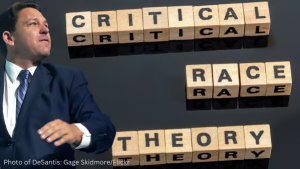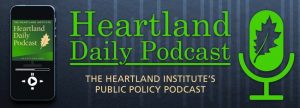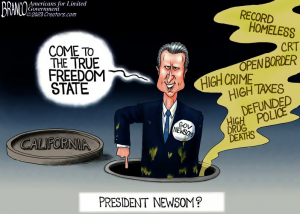COVID-style crime control means declaring states of emergency over gun violence in cities and states experiencing an explosion in crime rates.
You need to SUBSCRIBE to Life, Liberty & Property. Read previous issues.
IN THIS ISSUE:
- COVID-Style Crime Control
- Podcast of the Week: Rome: Strategy of Empire (Guest: James Lacey)
- Schooling the Higher Ed Establishment
- Good News and Bad News About the Economy
- Cartoon
- Video of the Week: ChatGPT Will Change Everything
- Bonus Video of the Week: Mutiny at the WEF?
Coming soon! Reserve your spot today!
COVID-Style Crime Control
 City and state governments across the country are declaring states of emergency over gun violence. The state of New York; Rochester, New York; Flint, Michigan; Portland, Oregon; and several other places declared emergencies in mid-2021, which are still in effect, The Center Square reports. Others have followed suit, and numerous city governments are currently considering such measures. A candidate for mayor of Philadelphia promised a couple of weeks ago to enact a state of emergency there on her first day in office if elected.
City and state governments across the country are declaring states of emergency over gun violence. The state of New York; Rochester, New York; Flint, Michigan; Portland, Oregon; and several other places declared emergencies in mid-2021, which are still in effect, The Center Square reports. Others have followed suit, and numerous city governments are currently considering such measures. A candidate for mayor of Philadelphia promised a couple of weeks ago to enact a state of emergency there on her first day in office if elected.
In emulating the government response to COVID-19, these emergency declarations will prove a waste of time, resources, and human lives.
The idea is that the local lawmakers will get more resources with which to fight crime: “Declaring a state of emergency grants additional powers to government and also makes them eligible for more government financial assistance, according to the executive orders put into place in numerous cities,” The Center Square reports.
Here’s what Gov. Andrew Cuomo promised New York in declaring a gun violence disaster emergency in July 2021:
Mr. Cuomo’s emergency declaration releases emergency funds that he will direct toward:
-
-
- Creating a gun violence prevention office, to be overseen by New York’s department of health
- Requiring police departments to provide incident-level data on shootings
- Investing $57 million in summer job programs for at-risk youth
- Combating flow of out-of-state firearms
-
Most of the emergency responses across the country are similar farragoes of potentially useful things the government should already have been doing plus an enormous wagonload of feel-good activities designed to show concern and to attack crime without getting criminals off the streets.
Does it strike you as odd that these cities are suffering from rapid increases in gun violence in the wake of the defund the police movement, the mass invasion of politically motivated criminal-coddling district attorneys and prosecutors whose campaigns were financed by the leftist billionaire George Soros, and the widespread denigration of police as institutional defenders of racism?
This spate of emergency declarations is highly reminiscent of the response to COVID-19: spread panic, obliterate everyone’s natural rights, spend a fortune, and completely fail to mitigate the problem, let alone solve it. Upon that failure, intensify the effort and demonize anyone who dares to disagree. In an alleged attempt to stop the spread of COVID-19, governors illegally locked down their states, telling people they could not shop, attend church, go to school, visit parks, etc. I use the word “alleged” because it is often a bad idea to take politicians at their word.
Under the COVID-19 regime, governments treated everyone as equally vulnerable and drove the nation into an unprecedented economic contraction, denied children an education during a critical time in their lives, revoked people’s rights to associate with one another and do business, bullied everyone into taking an experimental injection while denying access to proven-successful forms of treatment, and so on and on. COVID-19 spread throughout the population despite these efforts.
The same is true of these governments’ response to gun violence, and the result will be no better. Instead of concentrating attention on those who are most vulnerable to the scourge of gun violence and those most likely to spread it, governments treat everyone the same, giving vast sums of money to favored groups and engaging in public indoctrination. Crime spreads further.
If governments really want to reduce the number of murders and other violent crimes, they should concentrate their efforts on the places where the great majority of murders take place. These are readily identifiable, as John Lott of the Crime Prevention Research Center notes:
When it comes to murder, there are three types of counties in the United States. Most counties experience no murders, a smaller set where there are a few murders, and then a tiny set of counties where murders are very common.
Within the most murder-prone counties, the crimes are concentrated further:
The worst 5% of counties contain 47% of the population and account for 73% of murders. But even within those counties, the murders are very heavily concentrated in small areas.
“This concentration of murders is the highest in over a decade,” and the increase is driven by “the one percent of worst countries,” Lott observes.
The high murder rates in these places are not attributable to an extraordinary availability of firearms, Lott notes. Quite the contrary:
According to a 2021 PEW Research Center survey, the household gun ownership rate in rural areas was 79% higher than in urban areas. Suburban households are 37.9% more likely to own guns than urban households. Despite lower gun ownership, urban areas experience much higher murder rates. One should not put much weight on this purely “cross-sectional” evidence over one point in time, and many factors determine murder rates. However, it is still interesting to note that so much of the country has both very high gun ownership rates and zero murders.
Ethnic differences in crime rates complicate the matter politically, as social scientist and author Charles Murray notes in a recent book review:
The black-to-white ratio for violent crime arrests across all 13 cities averaged 10:1 [in 2013-2020]. In New York, Los Angeles, Chicago, and Washington, the ratios were 12:1, 9:1, 14:1, and 20:1 respectively. The Latino-to-white ratios were smaller, but usually big enough to be significant, with a mean of 3:1 across all 13 cities. The Asian arrest rate was about the same as the white rate in New York City and much lower in the other 12 cities. I should add that extensive scholarship establishes that racial differences in arrests correspond to differences in actual criminal activity, not police bias.
Effectively dealing with crime means being honest about these differences and foregrounding the fact that the very minority groups with high violent crime rates are the main victims of these crimes. If you want what is best for these ethnic groups, you will conscientiously protect them from the worst elements among them, those who keep their neighbors in terror for their lives, liberties, and property.
An effort to reverse the rise in crime is not to be a blame game regarding social groups. It must be a serious, realistic assessment of the problem and a wisely targeted response. Whatever may be the “root cause” of all these gun crimes, it is silly to treat everyone as equally vulnerable and identically likely to harm others, as governments did with COVID-19. A concerted attempt to establish order in the areas where the gun violence occurs is the most sensible response and one that is respectful toward individual rights and compassionate toward the victims and their families and loved ones.
Establishing order need not be a matter of draconian action by police, nor should it do harm to particular ethnic groups. Lott is known for his revolutionary and scientifically powerful observation that the more firearms there are in the hands of law-abiding people, the less crime they will be subjected to. Lott has further noted that people living in high-crime areas “benefit disproportionately” from laws allowing them to carry concealed handguns. In the case of gun violence, at least part of the solution is more freedom, not government oppression.
Governments must acknowledge reality and reverse the public-policy blunders that led to the increase in violent crime. Give police the proper amount of funding and effective crime-prevention resources while improving their training where necessary and rooting out any bad eggs. Remove rogue prosecutors who let violent criminals run free while harassing their political opponents and disfavored groups. Replace these purveyors of government malfeasance with honest public servants who will dutifully prosecute those caught committing crimes. Require bail before releasing plausibly accused people back onto the streets.
Above all, policymakers and opinion leaders must defend the proposition that people in low-income areas deserve a safe environment just as much as anybody else, and toward that end, the ethnic composition of prisons, police interactions, bail decisions, and the like should reflect those who commit the crimes, not the entire population.
Instead of implementing destructive, COVID-style policies that rely on a massive, ill-conceived, oppressive government response to the problem, policymakers should identify the vulnerable areas and concentrate on making them safe. As with COVID, not everybody is equally vulnerable to crime or identically likely to spread it.
Governments should learn from their mistakes. It is a great shame that such self-examination and repentance seldom happens. One wonders how many more people will have to endure criminal violence before governments reverse course.
Sources: Crime Prevention Research Center; The Center Square; The Claremont Review of Books (paywall); Capital Research Center; BBC
Podcast of the Week
Why Are So Many Cities Bankrupt? (Guest: Mark Moses)
Cities across the United States are in a persistent financial crisis because their governments are unable or unwilling to define who and what they are. In fact, many cities’ finances are so poor that they’re going bankrupt. The fundamental problem is that city governments attempt a scope of service provision that is impossible to deliver on.
Policy Analyst Mark Moses, author of The Municipal Financial Crisis: A Framework for Understanding and Fixing Government Budgeting, joins the Budget & Tax News podcast to discuss this problem.
Subscribe and Get Smarter
Schooling the Higher Ed Establishment

Gov. Ron DeSantis of Florida has been making news in recent months as a possible presidential candidate and, more importantly, as a state executive intent on improving the quality of life for his constituents—depending on your point of view. Naturally, The New York Times and the line of ducklings that follow it have put the worst possible construction on DeSantis’s actions, deriding his policies as mainly being political posturing aimed at the vast population of slack-jawed dimwits that make up the Republican Party across the country (and in 2016 somehow decided the party’s candidate for president):
On Tuesday, Governor DeSantis, a Republican, took his most aggressive swing yet at the education establishment, announcing a proposed overhaul of the state’s higher education system that would eliminate what he called “ideological conformity.” If enacted, courses in Western civilization would be mandated, diversity and equity programs would be eliminated, and the protections of tenure would be reduced.
The Times notes that DeSantis had already “moved to overhaul the leadership of the New College of Florida, a small liberal arts school in Sarasota that has struggled with enrollment, but calls itself a place for ‘freethinkers.’” (Apparently this passage was written without irony.) The New College “is regarded as among the most progressive of Florida’s 12 public universities,” the Times reports. DeSantis overhauled the college’s board of trustees by appointing conservatives, saying, “If it was a private school, making those choices, that’s fine, I mean, what are you going to do?” the Times quotes him as saying. “But this is paid for by your tax dollars.”
The new appointees include nationally prominent conservatives such as Christopher Rufo of the Manhattan Institute, Matthew Spalding of Hillsdale College, and Ryan Anderson of the Ethics and Public Policy Center, all of whom are strong critics of the drift of education away from what young people need to know and be able to do, and its replacement with political indoctrination into hatred of the United States and its history and institutions. The Times notes Rufo’s “vigorous attacks on ‘critical race theory.’”
The Times reporters acknowledge that DeSantis is not exactly on an island in his displeasure with the recent hard-left turn of the nation’s education system after decades of drift in that direction:
Mr. DeSantis’s embrace of civics education, as well as the establishment of special civics programs at several of the state’s 12 public universities, dovetails with the growth of similar programs around the country, some partially funded by conservative donors.
The programs emphasize the study of Western civilization and economics, as well as the thinking of Western philosophers, frequently focusing on the Greeks and Romans. Critics of the programs say they sometimes gloss over the pitfalls of Western thinking and ignore the philosophies of non-Western civilizations.
What should amaze and delight conservatives is how much success even a little pushback can achieve. The College Board, which creates and manages tests and associated curricula to help institutions of higher education ascertain how likely prospective students are to succeed in college, revised its AP History course to eliminate the most aggressive race-baiting elements, the Times reports:
After heavy criticism from Gov. Ron DeSantis, the College Board released on Wednesday an official curriculum for its new Advanced Placement course in African American Studies—stripped of much of the subject matter that had angered the governor and other conservatives.
The College Board purged the names of many Black writers and scholars associated with critical race theory, the queer experience and Black feminism. It ushered out some politically fraught topics, like Black Lives Matter, from the formal curriculum.
And it added something new: “Black conservatism” is now offered as an idea for a research project.
The Times singles out DeSantis as a motive force behind the change:
The pushback began in January, when Governor DeSantis of Florida, a Republican who is expected to run for president, announced that he would ban the curriculum, citing the draft version. State education officials said it was not historically accurate and violated state law that regulates how race-related issues are taught in public schools.
As I noted above, DeSantis is not alone in this effort to reform higher education. The Times reports:
In another red flag to the College Board, there was the possibility of other opposition: more than two dozen states have adopted some sort of measure against critical race theory, according to a tracking project by the University of California, Los Angeles, law school.
Prospective presidential candidate and current lamentable governor of California Gavin Newsom disagrees with these fine people, Fox News reports:
California Gov. Gavin Newsom on Wednesday slammed College Board CEO David Coleman as a “puppet of Ron DeSantis” after the Board revised an AP African American studies course by removing much of the content the Republican governor had criticized. …
“I call bulls—,” Newsom tweeted. “You are merely a puppet of Ron DeSantis.”
If only!
DeSantis had observed that teaching the AP course in public schools would be illegal in Florida:
DeSantis’s administration rejected the original course because “the content of this course is inexplicably contrary to Florida law and significantly lacks educational value.”
The administration specifically named topics of intersectionality, Black queer studies, the Black Lives Matter movement, Black feminist literary thought, the reparations movement, and the Black study and Black struggle in the 21st century as key concerns.
Regardless of one’s position on the fraught issue of America’s racial history, expecting people to obey the law might seem a reasonable position. After all, if the College Board perceives that it needs Florida more than it wants those elements of its proposed AP History curriculum, that is of course its prerogative—just as it was the organization’s right to propose them in the first place. We Americans are all for choice, aren’t we? The College Board responded as a rational actor, not a puppet.
The fact that the governor of California reacted with fury toward the College Board’s gesture toward legality should tell you that something exceedingly important is at stake here, if that were not already obvious.
Sources: The New York Times; The New York Times; Fox News; The Hill

Good News and Bad News About the Economy

Uh-oh, there’s more good news on the economy, which the Federal Reserve will see as very bad news and a reason to intensify its efforts to bring on a recession so as to reduce phantom inflation. The Wall Street Journal reports:
The U.S. labor market accelerated at the start of the year as broad-based hiring added a robust 517,000 jobs and pushed the unemployment rate to a 53-year low.
January’s payroll gains were the largest since July 2022 and snapped a string of five straight months of slowing employment growth, the Labor Department said Friday. The unemployment rate was 3.4% last month, its lowest level since May 1969.
President Joe Biden will be immensely pleased at those numbers and will claim credit for them, characterizing the decreasing unemployment as resulting from his grotesque spending spree of the past two years. Unemployment, however, is a lagging indicator and is going to be less and less of a problem as more and more Baby Boomers retire. (In fact, finding people who want to work is already becoming increasingly difficult.) The U.S. Bureau of Labor Statistics reports, “Total employment is projected to increase from 158.1 million to 166.5 million and grow 0.5 percent annually [from 2021 to 2031, which is slower than the 1.0 percent annual growth recorded over the 2011−21 decade.”
If the Fed continues to perceive low unemployment as a sign of a need for an economic contraction, it will bring on a recession. Biden will not be so happy about that, but he will have a genius response at the ready: a call for even more federal spending, to “stimulate” the economy. Upon which the Fed will feel forced to raise interest rates again and drag the economy down.
If the Fed fails to recognize the secular nature of the long-term trend toward low unemployment, this process could go on for a very long time. The American people will be the victims in this economic Punch and Judy show.
Sources: The Wall Street Journal; Alan Reynolds on Twitter; Alan Reynolds on Twitter; The Wall Street Journal
Cartoon of the Week

Video of the Week
The Heartland Institute’s Donald Kendal, Jim Lakely, Justin Haskins, and Chris Talgo present episode 383 of the In The Tank Podcast. You have probably heard at least a little bit about ChatGPT – an AI language model developed by OpenAI. I can assure you, you have not heard about it enough. This technology is going to drastically alter the landscape of many industries. The ITT crew discusses the potential of this new technology and talk about the implications it may have on our society. Also, we cover further confirmation that the media has gone off the deep end in the past several years in regards to bias.
BONUS Video of the Week
Klaus Schwab is the head of the World Economic Forum and one of the masterminds of The Great Reset agenda, as well as ESG social credit scores. But despite having amassed huge amounts of power and influence in recent decades, Schwab is now reportedly facing some serious threats from within his own organization. Will the Davos Man himself soon be thrown out of the WEF? What’s the real motivation behind the rumors? Justin Haskins and Donny Kendal break down this story in their latest episode of “Justin and Donald Save America.”












